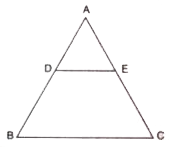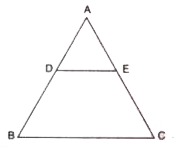ABCD is a parallologram. From C perpendiculars CS and CT are drpopped upon AB and AD, respectively. Given AB=16cm,CS=9cm,andCT=8cm, find BC.
The correct Answer is:18 cm
To solve the problem, we need to find the length of side BC in the parallelogram ABCD, given the following information:
- AB = 16 cm
- CS (height from C to AB) = 9 cm
- CT (height from C to AD) = 8 cm
1. Understanding the Area of the Parallelogram:
The area of a parallelogram can be calculated using the formula:
Area=Base×Height
2. Calculating the Area using Base AB:
We can take AB as the base of the parallelogram. Therefore, the area can be calculated as:
Area=AB×CS=16cm×9cm=144cm2
3. Calculating the Area using Base AD:
Now, we can also take AD as the base of the parallelogram. The area can also be expressed as:
Area=AD×CT
We know that CT = 8 cm, but we need to find the length of AD.
4. Setting the Areas Equal:
Since both expressions represent the area of the same parallelogram, we can set them equal to each other:
16cm×9cm=AD×8cm
This simplifies to:
144cm2=AD×8cm
5. Solving for AD:
To find AD, we can rearrange the equation:
AD=144cm28cm=18cm
6. Finding BC:
In a parallelogram, opposite sides are equal. Therefore, since AD = 18 cm, it follows that:
BC=AD=18cm
Final Answer:
The length of BC is 18 cm.
---
- CS (height from C to AB) = 9 cm
- CT (height from C to AD) = 8 cm
The area of a parallelogram can be calculated using the formula:
Area=Base×Height
We can take AB as the base of the parallelogram. Therefore, the area can be calculated as:
Area=AB×CS=16cm×9cm=144cm2
Now, we can also take AD as the base of the parallelogram. The area can also be expressed as:
Area=AD×CT
We know that CT = 8 cm, but we need to find the length of AD.
Since both expressions represent the area of the same parallelogram, we can set them equal to each other:
16cm×9cm=AD×8cm
This simplifies to:
144cm2=AD×8cm
To find AD, we can rearrange the equation:
AD=144cm28cm=18cm
In a parallelogram, opposite sides are equal. Therefore, since AD = 18 cm, it follows that:
BC=AD=18cm
The length of BC is 18 cm.
Topper's Solved these Questions
- BOOK - ICSECHAPTER - PERIMETER AND AREA EXERCISE - EXERCISE 17.316videos
PERIMETER AND AREA
- BOOK - ICSECHAPTER - PERIMETER AND AREA EXERCISE - REVISION EXERCISE24videos
PERIMETER AND AREA
- BOOK - ICSECHAPTER - PERIMETER AND AREA EXERCISE - EXERCISE 17.115videos
PERIMETER AND AREA
- BOOK - ICSECHAPTER - PERCENTAGE, PROFIT AND LOSSEXERCISE - REVISION EXERCISE26videos
PERCENTAGE, PROFIT AND LOSS
- BOOK - ICSECHAPTER - PROBABILITYEXERCISE - TRY THIS14videos
PROBABILITY
Similar Questions
In ΔABC, perpendiculars AP and CQ are droped from vertices A and C on opposite sides BC and AB, respectively. If AB=10cm,BC=16cm,AP=8.8cm, find PQ .
View SolutionIn figure, ABCD is a parallelogram, AE perpendicular to DC and CF perpendicular to AD. If AB = 16cm, AE = 8cm and CF = 10cm, Find AD.
View SolutionIn ΔABC,AD and CE are perpendiculars from A and C on the opposite sides. If AD=6cm.BC=14cm,AB=10cm,find CE.
View SolutionABCD is a rectangle measuring 60 cm by 50 cm P,Q,and R are the points on AB, AD , and BC, respectively, such that AP=40cm,AQ=20cm,andBR=40cm. Find the area of the polygon QPBCD.
View SolutionIn the given figure, a circle inscribed in a triangle ABC, touches the sides AB, BC and AC at points D, E and F respectively. If AB= 12 cm, BC= 8 cm and AC = 10 cm, find the lengths of AD, BE and CF.
View SolutionABCD is a trapezium in which AB||DC and P,Q are points on AD and BC respectively, such that PQ||DC, if PD=18 cm, BQ=35 cm and QC=15 cm. Find AD.
View SolutionIn ΔABC,∠ABC=∠DAC,AB=8cm,AC=4cmandAD=5cm.

Find BC and CD.View SolutionIn ΔABC, D and E are points on the sides AB and AC respectively. Find whether DE//BC, if :

AD=7cm, BD=45cm,AE=35cm and CE=56cmView SolutionIn ΔABC, D and E are points on the sides AB and AC respectively. Find whether DE//BC, if :

AD=3cm, BD=4.5cm,AE=4cm and AC=10cmView SolutionIn ΔABC,D and E are the points on sides AB and AC respectively.
Find whether DE || BC, if :
AB = 9 cm, AD = 4 cm, AE = 6 cm and EC = 7.5 cm.View Solution

